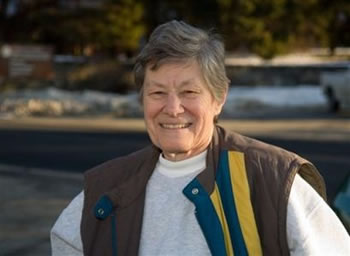Sister Ardeth Platte
Imprisoned for attacking a nuclear weapon
Imprisoned for attacking a nuclear weapon
Wikipedia
Risking Time In Jail To Build A Nonviolent World
http://www.hillconnections.org/ri/ardeth-platte-and-carol-gilbert-09ap.htm
'Orange is the New Black' character inspired by former Saginaw nun
 View full sizeFrom left, Laverne Cox, Beth Fowler and Kimiko Glenn in a scene from Netflix's "Orange is the New Black" Season 2. Beth Fowler plays the character Sister Jane Ingalls, who is based on Sister Ardeth Platte.JoJo Whilden | Netflix
View full sizeFrom left, Laverne Cox, Beth Fowler and Kimiko Glenn in a scene from Netflix's "Orange is the New Black" Season 2. Beth Fowler plays the character Sister Jane Ingalls, who is based on Sister Ardeth Platte.JoJo Whilden | Netflix
Sister Ingalls is no Sister Ardeth Platte.
But the TV nun on "Orange is the New Black" is inspired by the real-life woman who once served on the Saginaw City Council and made a name for herself as a peace activist.
"I never tied myself to a flagpole," scoffed Platte of the Netflix version of herself. "I go into nuclear weapons sites to pray, to vigil, to expose what is there, to try to speak my peace about total abolition of nuclear weapons."
And periodically, Platte serves time in prison.
The Netflix drama "Orange Is the New Black" is based on the book of the same name about Piper Kerman's experiences in a Connecticut women's prison. The autobiography details how Kerman, through a brief relationship with an international drug runner, became a mule, a past that caught up to her years after she'd found a more productive use for her talents.
"On my first day in the Camp someone had helpfully informed me that there was a nun there — in my side-smacked daze, I vaguely assumed they meant a nun who had chosen to live among prisoners," wrote Kerman. "I was correct, sort of. Sister Ardeth Platte was a political prisoner, one of several nuns who are peace activists and served long federal sentences for trespassing in a nonviolent protest at a Minuteman II missile silo in Colorado."
Sister Ardeth Platte moved to Saginaw in 1966 to serve as principal and director of alternative education at the former St. Joseph's Educational Center. She was a Saginaw city councilwoman from 1973 to 1985 and began a dozen years as coordinator of Saginaw's Home for Peace and Justice in 1978.
In the late '80s, Platte was a frequent visitor outside the former Paul B. Wurtsmith Air Force Base in Oscoda, where the Dominican nun led protests against nuclear weapons.
After her arrest and conviction in Colorado, Platte served time alongside Kerman. As Kerman wrote, "only the nun got more mail than me."
"They used to bring it in buckets," Platte recalled of the volume of mail she received. "Sister Carol (Gilbert) and Sister Jackie (Hudson) and I were in different prisons. Mail came in from every continent, from all over the world. It was thousands of letters. That's why we know people are really concerned about nuclear weapons and their illegality and the need to continue to witness to getting rid of them. We believe there's another way to solve conflict rather than war and threats of war."
Has Platte read Kerman's book, in which she appears a handful of times?
"I have read it," said Platte, who lives in the Jonah House in Baltimore and called "it was a privilege to be with" Kerman in prison.
"Her entire book is absolutely excellent. She recorded prison life as prison life is, from her perspective. ... She is using that across the country for possible prison reform."
The admiration was mutual. Platte, Kerman wrote, is "one tough nun, an adorable, elfin, twinkling and loving presence."
The TV show takes liberties with Kerman's autobiography, including changing some details of Platte's bio and her very name. Does Platte watch the show? Not at all.
"There's too much license with it," she said. "It probably has too much license in it for me, though I know a lot of people say, 'It really has taught me a lot.'"
Among the license that the show takes: The women at Federal Correctional Facility, Danbury wear khaki scrubs, not orange jumpsuits. "Khaki Was Our Orange" just doesn't have the same panache.
Kerman details the inmate hierarchy, the food, the menial labor and the friends she made. At Danbury, she discovered yoga, which she practiced with a handful of women including Platte.
"Sister had tight hips, so twists and Pigeon Pose prompted a knitted brow, and if she had indulged in some greasy home fries at the midday meal, the forward bends would give her trouble," Kerman wrote on page 70. "When I sank into a deep lunge, a tiny nun would study me, plaintively wondering, "What am I doing wrong?"
"I smile at that," Platte said after listening to the passage. "She's very descriptive, isn't she? I still do yoga at times. I don't have enough time to do it every day."
Platte, 78, has a day job, and that's her mission to promote nuclear disarmament.
Even so, she said, "I come back to Saginaw annually."
"The Home for Peace and Justice that is there does still focus on nuclear weapons and war," she said.
"I love Saginaw. The people that surrounded me in Saginaw are still with me. We have extensive communication across the miles. I'm just closer to the Pentagon and the White House now."
|
The Netflix nun on "Orange is the New Black" is inspired by the real-life Sister Ardeth Platte, who once served on the Saginaw City Council.
| |||||||
Preview by Yahoo
| |||||||



No comments:
Post a Comment